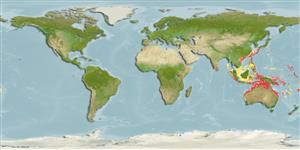Common names from other countries
Classification / Names / Names
Namen | Synonyme | Catalog of Fishes (gen., sp.) | ITIS | CoL | WoRMS
Environment: milieu / climate zone / depth range / distribution range
Ökologie
Riff-verbunden; tiefenbereich 21 - 80 m (Ref. 2352). Tropical; 51°N - 58°S (Ref. 356)
Northeast Atlantic to Western Pacific.
Length at first maturity / Size / Gewicht / Alter
Maturity: Lm 91.0, range 91 - 116.2 cm Max length : 148 cm SVL Männchen/unbestimmt; (Ref. 2355); common length : 80.0 cm SVL Männchen/unbestimmt; (Ref. 2355)
Head is wide or slightly wider than body except for rostral and nasal plates. Supra-cephalic scales are completely fragmented. Nasals generally contact each other. Nostrils situated dorsally on the head. Fragmented scales on top of the head are covered with many spicules. Loreal plate between rostral and preocular plates is present. Eyes are separated from supralabial scales by a row of large subocular scales. Dorsal scales are generally smooth, seldom with a slight median keel or a series of small knobs; imbricate and distributed in 19 rows midbody and sometimes covered with small diffuse blunted tubercles. Ventral scales are broader than dorsal scales and range from 150 to 175 in number. With median keel that is not clearly delineated especially on anterior part of the body, not or very slightly posteriorly imbricate. Anal plate divided. Tail is long and moderately enlarged. Subcaudal scales are wide and simple and distributed in 23 to 35 rows (Ref. 2357, 2355). Has highly variable coloration and patterns. Chin and throat region is generally paler than rest of the body, becoming darker posteriorly. Fine white rim along the edge of the dark scales is always present. Ventral side coloration ranges from uniform dark brown to creamy white. Base color varies from whitish-beige to brown or brownish purple, with relatively dark rings and white or creamy patches, especially on the lower sides. Some rings are V-shaped and dorsally truncated. Edges of each scale are clearly palish cream colored, forming a mesh along entire dorsal area. Dark brown coloration is often limited to patches on individual scales, thus transforming the base color into pale cream or salmon with darker rings (Ref. 2352).
Minimum depth from Ref. 101715. Maximum and common lengths also from Ref. 2352. Inhabits solid substrates and sandy-silty sedimentary zones with seaweed or invertebrates for shelter, such as gorgonian and antipatharian corals, and sponges (Ref. 2355) in shallow waters to a depth 80 m. Feeds usually on moray eels and on various benthic fish within size range, 6 to 7 cm. Stalks prey along seabed. Generalist and opportunistic feeder. Venom delivered is highly toxic but not very dangerous to humans (Ref. 2352). May be associated with algae, bryozoans, polychaetes and tubeworms with encrust on it (Ref. 98471).
Life cycle and mating behavior
Geschlechtsreife | Fortpflanzung | Ablaichen | Eier | Fecundity | Larven
Viviparous. Gravid females group during the southern autumn (Ref. 2352).
Ineich, I. and P. Laboute. 2002. (Ref. 2352)
IUCN Rote Liste Status (Ref. 130435)
CITES Status (Ref. 108899)
Not Evaluated
Not Evaluated
Nutzung durch Menschen
| FishSource |
Tools
Internet Quellen
Estimates based on models
Preferred temperature
(Ref.
115969): 23.8 - 28.8, mean 27.3 (based on 572 cells).
Widerstandsfähigkeit
hoch, Verdopplung der Population dauert weniger als 15 Monate. (K=0.55).
Verwundbarkeit
Moderate vulnerability (41 of 100).
Preiskategorie
Unknown.
